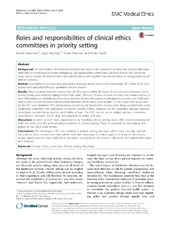| dc.description.abstract | Background: Fair prioritization of healthcare resources has been on the agenda for decades, but resource allocation dilemmas in clinical practice remain challenging. Can clinical ethics committees (CECs) be of help? The aim of the study was to explore whether and how CECs handle priority setting dilemmas and contribute to raising awareness of fairness concerns. Method: Descriptions of activities involving priority setting in annual reports from Norwegian CECs (2003-2015) were studied and categorized through qualitative content analysis. Results: Three hundred thirty-nine reports from 38 CECs were studied. We found 78 activities where resource use or priority setting were explicitly highlighted as main topics. Of these, 29 were seminars or other educational activities, 21 were deliberations on individual patient cases, whereas 28 were discussions of principled or general cases. Individual patient cases concerned various distributional dilemmas where values were at stake. Six main topics and seven roles for the CEC were identified. CECs handle issues concerning the introduction of new costly drugs, extraordinarily costly established treatment, the application of priority setting criteria, resource use for vulnerable groups, resource constraints compromising practice, and futility of care. The CEC can act as an analyst, advisor, moderator, disseminator, facilitator, watch dog, and guardian of values and laws. Discussion: In order to fulfil their responsibilities in handling priority setting cases, CECs need knowledge of both the ethics and the institutionalized systems of priority setting. There is potential for developing this aspect of the CECs’ work further. Conclusions: The Norwegian CECs are involved in priority setting decisions where they can play multiple constructive roles. In particular, they advise and raise awareness of ethical aspects in resource allocations; bridge clinical practice with higher-level decisions; and promote fair resource allocation and stakeholder rights and interests. | en_US |

